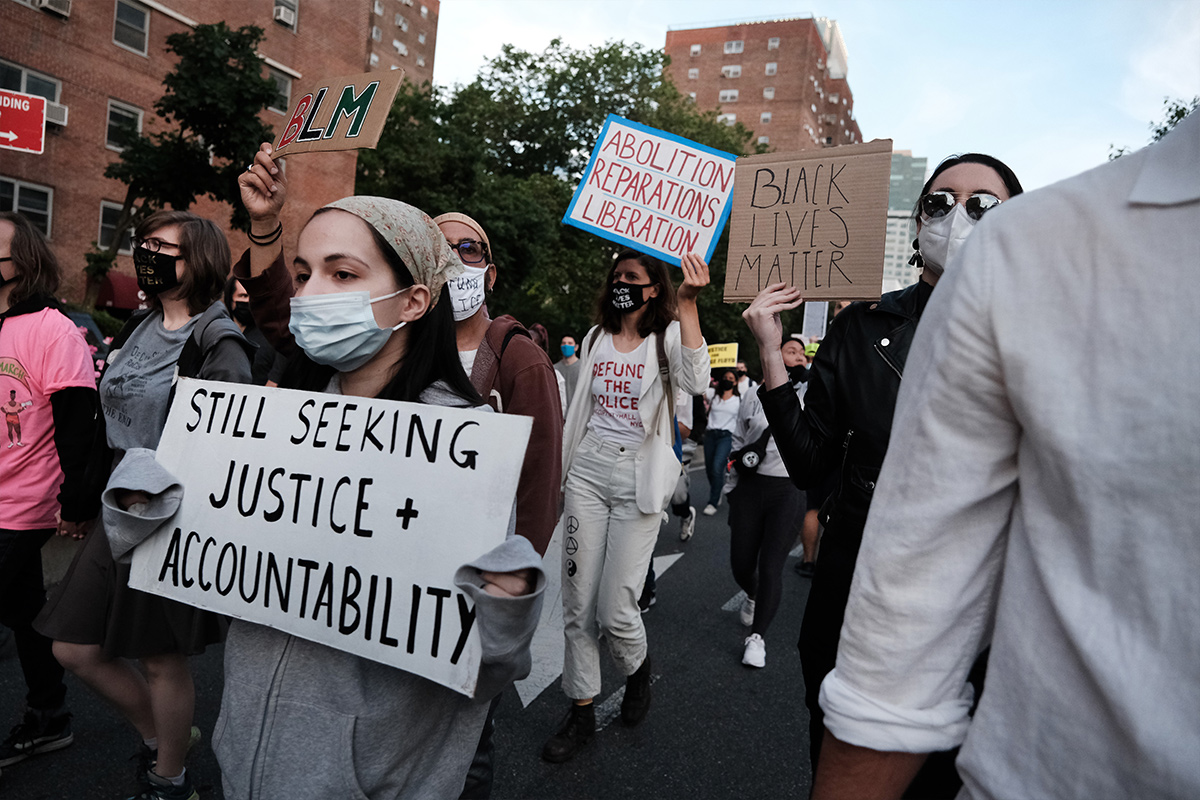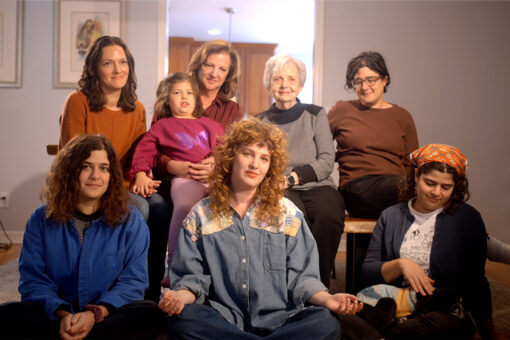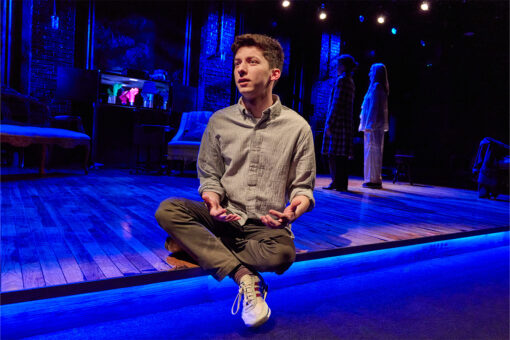Over a year ago, the Not Free to Desist collective published a letter by Black Jews, Jews of Color, and allies, calling on Jewish organizations to take concrete action for racial justice. The letter named commitments ranging from creating internal accountability protocol for addressing incidents of racism, to diversifying board membership and leadership. The work of racial justice is both outward- and inward-facing, requiring practitioners to examine themselves and the world around them. It can be both fulfilling and emotionally draining, and in many communities, it has been ongoing for years.
“Last summer there was just this onslaught,” says Beckee Birger, the Program Director of the Research Training Internship at the Jewish United Fund of Metropolitan Chicago (JUF). “And one thing I was saying at that time was, what are you going to be doing this time next year? Because this is not about a cultural moment that we’re in, it’s about a foundational shift.”
Beckee works with teens and teaches leadership development at JUF, and she also does private consulting with congregations in her community who are looking for external help in facilitating tough conversations about race. One of the biggest misconceptions that she encounters is that advocating for and leading anti-racist initiatives requires elite skills or training. “What I want for is everybody to be able to have these conversations and trust that they’re messy and they’re hard,” she says, “but actually we all inherently have the tools to do anti-racist work.” Beckee has found that people aren’t unwilling to see race; they’re often just reluctant to discuss it. While adults may grapple with new concepts for the first time in her programs, she’s noticed that young people across the political spectrum jump in with greater familiarity and less discomfort talking about race.
Beckee is one of many educators and activists who have been chipping away at this work for years. Educational psychologist Dr. Deitra Reiser has always been interested in what motivates people to change their thoughts and behaviors. “For someone to want to change, it needs to be meaningful, and it needs to be personal,” she says. “Not all white people recognize how race and racism impact their lives.”
Deitra is the founder of Transform for Equity, a consulting firm that does coaching, workshops and discussions with organizations in the Washington, D.C. area, including the Union for Reform Judaism. Following the 2016 election, she took the lead of Multiracial Sinai, an anti-racist movement within her synagogue, because she wanted her children — who are Black and Jewish like her — to feel like they had a welcoming spiritual home there.
Jessie Sander and Elana Lipkin grew up in Orange County, New York, which tends to swing red in elections. They both attended Monroe Temple Beth-El growing up, and as adults with experience in education and social work, wanted to make the Not Free to Desist letter’s specific calls to action a reality in their community. Inspired by the name of their synagogue’s preschool program — Menschmakers — they created Making Mensches, an educational initiative focused on anti-racism and tikkun olam, or the Jewish concept of repairing the world.
The failure of the diversity, equity, and inclusion (DEI) initiative is well-documented, and that’s just in the secular world. American Jewish communities are a complex and shifting landscape, and they’re far from immune to the effects of American racism. Black Jews and Jews of Color consistently run up against everything from microaggressions at temple (for example, the assumption that Jews of Color are new to Judaism), to a lack of representation and erasure in Ashkenormative environments, to the complacency of progressive spaces resting on their laurels. The reckoning of last summer was long overdue.
But measuring change in terms of a community’s attitudes regarding racial justice is a difficult pursuit. Beckee looks for several benchmarks in her work with synagogues. She grew up with the false narrative that she was a “rare unicorn” as a Black Jew, when in fact Jews of Color are estimated to comprise 20% of the United States’ Jewish population. Pushing the needle means shifting baseline assumptions about Jewish diversity. Beckee also looks at how synagogues respond to critical issues in their community. One of the most popular lenses she sees is a charity model: “We can volunteer around this thing, we can go to a community kitchen, we can go to a food bank, because we know that hunger is an issue in our community, but we’re not actually going to talk about how that happened or why that is,” she says. “For a long time we just accepted it as a default.” Instead, she wants to push congregations to question the power structures around them that have created poverty and inequity.
Similarly, Deitra was initially drawn to Temple Sinai because of its strong Social Action Committee. While many Reform synagogues will describe their committee responsible for advocacy and social justice-related programming as “Social Action,” what the phrase means in practice differs from congregation to congregation. “I know that often when social action is happening, and people have not done the internal work of being anti-racist and understanding the ‘why’s’ of what’s being worked at, sometimes the motivation behind doing the work is not anti-racist,” she says. Deitra wanted to get at the heart of that “why.” In order to help her community members effectively address racism as a systemic (rather than interpersonal) issue, Deitra’s focus is on building skills and what she calls racial stamina, a framework that aims to strengthen participants’ ability to sustain conversation and action towards racial justice.
Jessie and Elana wanted to leverage their privilege as white Jews within their community. Following the seven obligations outlined in the Not Free to Desist letter, they began by proposing educational workshops for Temple Beth-El, and later for other Jewish communities in the Orange County area and the Northeast. Their goal in engaging affinity group-based education — working within both established units like Sisterhood, and open groups — is to create more affirming environments for Jews of Color by taking on the burden of education. They have found that white participants will more freely ask questions or share microaggressions that they can then unpack without exposing Jews of Color to that harm. At the same time, they are trying to balance the implications of positioning themselves as experts by centering the voices of Black Jews and Jews of Color in their work.
These approaches speak to the importance of balancing the urgency of racial justice with the depth and delicacy required of the work. It must happen now, but it can’t be rushed — a synagogue can post a sign that reads “All Are Welcome Here,” while still engaging in harmful practices, and without dedicating itself to authentic critical reflection. Beckee has observed congregations struggle to find creative solutions to the question of resourcing; organizations may add the work to the plate of an individual staff person or volunteer internally or look for one-off solutions like a single-day training, when more drastic, sustained interventions are often necessary.
Deitra, Beckee, Elana and Jessie all take an intersectional approach with a distinctly Jewish lens. “How is it that our Jewish identity impacted the way that we see race?” asks Deitra. “We really hold up those experiences as Jews to inform and understand better how we’ve interacted with people of other races, and how we can understand our society.” Deitra makes a lot of room for the varying experiences and perspectives of others, but she makes a few things definitively clear. “You cannot be antisemitic and anti-racist,” she says. This work can only be done in coalition, where shared human dignity is a priority.
Likewise, one of the biggest hurdles that Making Mensches addresses head-on is the complicated discussion about how white Ashkenazi Jews can occupy positions of privilege and power based on race, while still experiencing antisemitism. “I don’t think of Making Mensches as a DEI organization as much as a community care organization,” says Elana, “because I think at the end of the day what we’re prioritizing is how are we building communities of love and care, and how can we make sure that every Jewish person is welcome in these spaces.” Jessie agrees: “We don’t want to just be inclusive,” she says. “We want to restructure Jewish communities, in the sense that this isn’t something the secular world is forcing us to do at the workplace, this is something that has always been core to who we are as Jews.”
Beckee thinks about liberation broadly — she wants to avoid siloing discussions about race from discussions about other issues that affect Jews. “We should really be thinking holistically about who isn’t in our spaces and why, across a lot of dimensions,” she says. “The ideals I’m trying to teach people about who has power, who is struggling, who is welcome, who is the default, what’s normative in your space, and how do you describe that — I hope that people are using those tools to think about race, but also gender and sexuality and disability and income.”
The pain of our communities won’t be healed in a single anti-bias training, or a service project, or a strongly-worded letter to donors. The spotlight of last summer may have faded, but the call to action from Not Free to Desist and others remains. A rising tide lifts all boats — but what synagogues, day schools, philanthropic groups, fellowships and other Jewish organizations do next is up to them.



